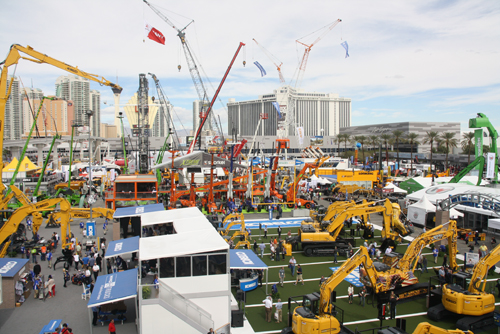Cautious Outlook at CONEXPO 2014

The triennial show drew its second-highest attendance ever, at 129,364, an 8% lift over 2011 but still down from the 2008 high point of 144,000.
Attitudes among roadbuilders attending the industry's largest expo were positive. Budgets have returned to higher levels, and more work is available. "Orders so far in 2014 have been steady," said Ben Brock, chief executive officer of Astec Industries, which displayed 41 new products at CONEXPO-CON/AGG 2014, held on March 4-8 in Las Vegas.
However, not all equipment categories are as rosy. A slowdown in mining has hit sales of large earthmovers, and contractors are renting more and holding onto assets longer. Doug Oberhelman, chairman and CEO of Caterpillar Inc., said he remains "very guardedly optimistic" about 2014. Likewise, the global crane market is still "lumpy," noted Larry Weyers, global executive vice president of Manitowoc Cranes.
Despite this uncertainty, the competitive atmosphere was intense. Manitowoc, which is tangled up in a patent lawsuit against Chinese rival Sany America, unveiled new 330-ton MLC300 and 716-ton MLC650 crawlers. Both sported a Variable Position Counterweight that allows users to set up cranes with less hassle. Sany, which claimed to have developed its own unique design, showed a similar system on its 550-ton SCC8500.
"The traveling of counterweights to a jobsite—and the associative costs—are one area where the MLC300 will begin saving our customers money," said Kris Liptak of Cleveland-based All Erection & Crane Rental, which purchased 10 of the Manitowoc units; each retails for more than $2.5 million. Elsewhere, Terex Corp. fired a warning shot at rival JLG Industries for allegedly copying Genie's patented X-shaped chassis on its 180-ft-tall SX-180 boom lift. At the show, JLG debuted its 185-ft 1850SJ Ultra Boom, featuring a similar chassis and beating Genie's world record for height by just 5 ft.
The triennial show drew its second-highest attendance ever, at 129,364, an 8% lift over 2011 but still down from the 2008 high point of 144,000. "A recurring theme at CONEXPO was caution toward the exuberance among show attendees," wrote J.P.Morgan analyst Ann Duignan in an investor note after the show. "Indeed, Manitowoc management noted that while the tone at the show was generally bullish, it was yet unclear whether customer optimism would translate into orders." Weyers told ENR he predicted a 3% to 5% lift in sales in 2014 and expressed concern about political unrest in the Ukraine spilling into Eastern Europe.
As more than 1,000 new products were on display at the exhibit, many manufacturers used the opportunity to showcase their clean-diesel engines that meet Tier 4 Final federal emission levels. Manufacturers said the engines were more fuel-efficient, though contractors said the gains were tempered by higher maintenance costs, such as the need to add diesel exhaust fluid (DEF) to combat exhaust pollution.
In the machine exhibits, "fluid economy" was the new buzzword. "It's about a net-cost reduction," said Richard Smith, vice president at Komatsu, speaking of its Tier 4 engines, which are designed to burn 7% less fuel and require DEF refills at a rate of 2% to 3.5% of fuel burned. Other vendors, particularly ones showing small, compact equipment, were quick to point out which of their machines do not require DEF or, in rare instances, run on other fuels. Vendors also speculated about the possibility of a Tier 5 global diesel standard that would include new greenhouse-gas limits.
Although hybrids were less of a focus than at prior shows, manufacturers with existing hybrids, such as Caterpillar and Komatsu, showed updated models. Meanwhile, engine consultant Ricardo unveiled flywheel energy storage for excavators that promises 10% fuel gains using simple components. Of the unnamed manufacturers looking to install it, at least one did not plan to call its flywheel-equipped excavator a hybrid for fear the label may turn off customers. "Their thinking is that, if they don't call it a hybrid, they can put flywheels into every machine and sell on fuel economy alone," said David Rollafson, Ricardo vice president.
Vendors highlighted new tech that emphasized mobility and telematics aimed at helping contractors widen slim profit margins. Komatsu rolled out four "intelligent" dozers whose 3D machine controls are baked in at the factory to offer greater precision. Earthcam unveiled a super-high-resolution, 10-billion-pixel web camera as well as a basic work-zone model with no monthly fee. FieldLens used Google Glass to show its new productivity platform, and, although not exhibitors, representatives at construction start-ups YardClub.com and Material Tracker.com were walking the aisles to promote new peer-to-peer trading sites.
The intense pressure to innovate—whether spurred by regulations or other market forces—had noticeably hit vendors' research-and-development budgets, some attendees said. "In the same way that Tier 4 has exhausted the equipment guys, cloud and tablet computing has exhausted the tech guys," observed Mike Vorster, professor emeritus at Virginia Tech and president of fleet-management consultant CEMP Central Inc.
While the established players were busy playing catch-up, newer entries took the opportunity to introduce themselves. Chinese vendors Sany, Zoomlion, Liugong, Lonking and others were looking to expand distribution in the U.S., while Europe-based manufacturers Sennebogen and Wolffkran made their U.S. debuts.
Read more coverage of CONEXPO-CON/AGG 2014 at ENR.com/CONEXPO.


